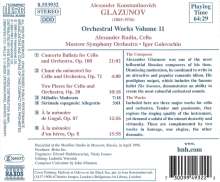Alexander Glasunow: Werke für Cello & Orchester auf CD
Werke für Cello & Orchester
Herkömmliche CD, die mit allen CD-Playern und Computerlaufwerken, aber auch mit den meisten SACD- oder Multiplayern abspielbar ist.
Lassen Sie sich über unseren eCourier benachrichtigen, falls das Produkt bestellt werden kann.
Concerto Ballata op. 108; Chant du menestrel op. 71; 2 Stücke op. 20; A la memoire de Gogol op. 87; A la memoire d'un heros op. 8
- Künstler:
- Alexander Rudin, Moscow Symphony Orchestra, Igor Golovschin
- Label:
- Naxos
- Aufnahmejahr ca.:
- 1996
- UPC/EAN:
- 0730099493222
- Erscheinungstermin:
- 26.7.1999
- Serie:
- Naxos British Light Music
Ähnliche Artikel
Das Concerto Ballata wurde 1931 geschrieben und ist Pablo Casals gewidmet. Es wird allein vom Violoncello eingeleitet und führt die Erzählung an, bis eine Passage von orchestraler Spannung einsetzt, mit einer an Elgar erinnernden Melodie mit absteigenden Sequenzen für den Solisten, vom Orchester in einiger Agitiertheit wieder aufgenommen wird. Auf Elemente der Eröffnung folgt eine As-Dur-Passage mit der Bezeichnung Tranquillo, gefolgt von einem Adagio, quasi eine Ballata, während sich die Erzählung entfaltet. Eine c-Moll-Kadenz erlaubt es dem Cello, die Geschichte fortzusetzen, schließlich in großer Einfachheit vor einer weiteren, längeren Kadenz. Es folgt ein Allegro marciale, dann ein Allegretto scherzando, das dann abbricht. Mit einem Hauch von trotzigem Optimismus folgt der letzte Abschnitt, dessen letzter Abschnitt vom Cello in fortgesetztem Doppelgriff begleitet wird und ein Werk von sicherer und gekonnter Handwerkskunst beendet.
Der "Chant du ménestrel" ("Minnesängerlied") wurde 1900 geschrieben, ein ergreifendes Minnesängerlied, mit einem Stimmungswechsel im Mittelteil, bevor die Holzbläser mit der ersten Melodie zurückkehren. Die beiden Stücke für Violoncello und Orchester sind noch älter und stammen aus den Jahren 1887 und 1888. Die Mélodie ist zart instrumentiert, wobei der Melodieverlauf des Cellos immer gebührend hervorgehoben wird. Die "Sérénade espagnole" ("Spanische Serenade") verwendet in ihrer Orchestrierung eine Harfe und gezupfte Saiten, eine gelungene russische Reminiszenz an Spanien, vielleicht eine Erinnerung an Glazunovs Besuch in diesem Land mit Beljajew im Jahr 1884.
Glazunovs Hommage an Gogol wird als symphonischer Prolog beschrieben und wurde 1909, zum hundertsten Geburtstag des Schriftstellers, geschrieben. Sie beginnt im düsteren russischen Stil, bevor sie in eine Stimmung zarterer Erinnerung übergeht, mit einer abschließenden Hymne, die die Substanz des grandiosen Schlussteils bildet. Die Hommage an einen anonymen Helden wurde 1885 geschrieben, als der Komponist zwanzig Jahre alt war, und trägt den Untertitel Elégie. Sie nimmt einen allgemein elegischen Verlauf mit russischem thematischem Material, von der Eröffnung in cis-Moll und einer motivischen Entwicklung in gesichertem Kontrapunkt bis hin zur endgültigen Stimmung ruhigen Optimismus. Das gesamte Werk ist eine Demonstration von Glazunovs früher Beherrschung der Kompositionstechniken und seiner natürlichen Verwendung der russischen Melodie.
Product Information
The Concerto Ballata was written in 1931 and is dedicated to Pablo Casals. It is introduced by the cello alone, leading the narrative until a passage of orchestral excitement intervenes, with an Elgarian melody of descending sequences for the soloist, echoed by the orchestra in some agitation. Elements of the opening are followed by an A flat major passage marked Tranquillo, followed by an Adagio, quasi ballata, as the tale unwinds. A C minor cadenza allows the cello to continue the story, finally in terms of great simplicity, before another, longer cadenza. There follows an Allegro marciale, then an Allegretto scherzando, which breaks off. The final section follows, with an air of defiant optimism, its final section accompanied by the cello in continued double-stopping, ending a work of sure and skilled craftsmanship.
The Chant du ménestrel (‘Minstrel's Song’) was written in 1900, a poignant minstrel's song, with a change of mood in the central section, before the woodwind returns with the first melody. The Two Pieces for cello and orchestra are still earlier, dating from 1887 and 1888. The Mélodie is delicately orchestrated, always giving due prominence to the cello melody-line. The Sérénade espagnole (‘Spanish Serenade’) makes use of a harp and plucked strings in its orchestration, an accomplished Russian evocation of Spain, perhaps a recollection of Glazunov's visit to that country with Belyayev in 1884.
Glazunov's tribute to Gogol is described as a symphonic prologue and was written in 1909, the centenary of the writer's birth. It opens in sombre Russian style, before moving into a mood of more tender recollection, with a final hymn to form the substance of the grandiose closing section. The homage to an anonymous hero was written in 1885, when the composer was twenty, and has the sub-title Elégie. It takes a generally elegiac course, with Russian thematic material, from its opening in C sharp minor and motivic development in assured counterpoint until its final mood of calm optimism. The whole work is a demonstration of Glazunov's early mastery of the techniques of composition and his natural use of Russian melody.
Rezensionen
L. Franke in FonoForum 12/99: "Alexander Rudins Ton ist fein, ohne dünn zu sein; technische Schwierigkeiten bewältigt er mit Eleganz. Igor Golovschin und sein vorzügliches Orchester gestalten sicher und geben selbst schwächeren Episoden Gewicht."-
Tracklisting
-
Mitwirkende
Disk 1 von 1 (CD)
-
1 Concerto ballata, Op. 108: Cello Concerto Ballata, Op. 108
-
2 Chant du menestrel for Cello and Orchestra, Op. 71
-
3 2 Pieces, Op. 20: I. Melodie: Moderato
-
4 2 Pieces, Op. 20: II. Serenade espagnole: Allegretto
-
5 A la memoire de Gogol, Op. 87
-
6 A la memoire d'un heros, Op. 8
Mehr von Alexander Glasunow
-
Alexander GlasunowSymphonie Nr.6CDAktueller Preis: EUR 17,99
-
Alexander GlasunowDie Jahreszeiten op.67CDAktueller Preis: EUR 14,99
-
Alexander GlasunowSymphonien Nr.1-85 CDsVorheriger Preis EUR 36,99, reduziert um 0%Aktueller Preis: EUR 26,99
-
Alexander GlasunowSymphonie Nr.8CDAktueller Preis: EUR 7,99











